By Freeman Lloyd from Dog Breeds of the World (somewhat abridged)
AKC Gazette February, 1936 - Part I
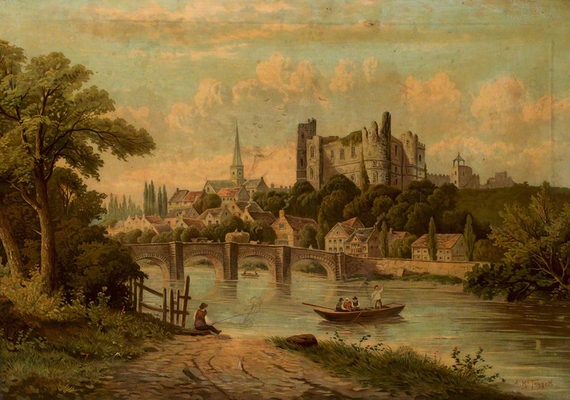
Haverfordwest Castle
It was in and around the ancient town which Master William Shakespeare was pleased to call "Harfordwest in Wales," the Welsh corgi - or miniature cattle, sheep and swine-fold dog - of Pembroke type was first seen. And where better, it may be asked, than in the home of my fathers and my own birthplace?
There was never a fair and market day we did not see scores of the little farm dogs either following their masters and mistresses from the country sides, or at the heels of herds of cattle, flocks of sheep, or driving pigs.
To the small grazier the corgi was as important an animal as any on his other holding. As a herd dog, he was ever handy. But he was mostly looked upon as a more suitable dog for the fold than for the faster-going work of a sheepdog proper, in a hilly country where mountain sheep had almost the agility of antelopes.
It was north and east of Haverford Castle that was and is considered the corgi country. Especially so was this the case in the north, which the inhabitants of "Little England Beyond Wales" usually describe as "Up In The Welsh." This district is given over to agriculture, stock raising and forestry. There are no manufactures.
There has always been an invisible line of feeling and stand-offness between the peoples of the north and south. The northerners are pure-bred Welshmen; whereas the southerners are made up of several strains or bloods including those of Norsemen, Normans, Flemings, and other peoples of Continental races. Pirates, buccaneers, soldier-conquerors became mixed up with the Welsh on the Coasts; and when hundreds of Flemish civilian adventurers arrived around Haverford in the time of Henry II, and intermarried with the Welsh, there was produced a new race, which, eventually, drove to the back country, the Welsh-speaking people.
With the retirement of the Welsh, went their corgi dogs - the small breed of fold dogs which were looked upon not only as a farm or livestock dogs, but barking as well as biting four-footed friends. They were handy and game enough to tackle vermin; and as killers of rats and other unwanted rodents they were excellent. In short, the corgi was and is considered a farm dog of all work.
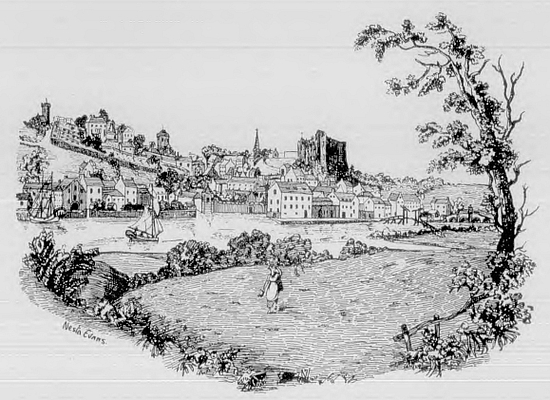
In the drawing - after an old 19th Century print - directly underneath the centre of a tower may be seen two small buildings. The one on the left was my father's stable where, as a boy, I kept dogs, ferrets, hawks and other creatures for which most lads have a liking. If that were not enough to give especial pride and interest to one, what shall we say when it is related the sketch was made by Miss Nesta Evans, a sister, it is believed, of Miss Thelma Evans, author of the first work on The Welsh Corgi. This excellent monograph is published by Watmough's Limited, of Idle, Bradford, England.
I have taken some trouble to discover the anglicized meaning of corgi. Like quite 80 per cent of Haverfordians, I know little or nothing of the tongue of the ancient Britons - the Welsh. So, I have had to depend on old and young friends for information.
In the main, it is quite apparent that "corgi" means "a small dog". Thomas Davies, Assistant Director of Education for Wales, was kind enough to inform my correspondent, Rhys Birch, of Haverford, that: "Cor, as a noun, means point or dwarf. As an adjective, it means small, little, dwarf, lesser." Therefore, "corgi" means a small dog.
Miss Evans is of pure Welsh extraction, and probably is well acquainted with its language. In her book she says the word "corgi" is usually accepted as being a combination of the words "cor" meaning "dwarf" and "gi" meaning "dog". It is also likely that it may have its original in "cur" meaning "to watch over" in view of the dogs' work of guarding farms and watching over cattle.
This, in my opinion, is an excellent suggestion and brings to the mind that to many of us who lived in "Little England Beyond Wales", the term corgi was practically unknown even to "doggie" people.
The long backed and short legged farmer's dog was known as the "Welsh Cur". I am one of those who regret the word was employed to distinguish a supposed to be impure-bred dog from those believed to be of the more lofty or pedigreed kinds.
It is with further apologies this important matter is mentioned for the very reason that now we come to think of it, the livestock keeper's "curs" or corgis actually were more true to type than many of the other dogs we were pleased to look upon as being pure-bred or of spotless lineage. Among these were the scores of offcasts from Sealy Ham which produced a now distinguished race of dogs.
Aye, sirs, 'twas only a small strip of Welsh soil, of about the same area as that of Westchester County, New York, which gave to the world three notable varieties of dogs. They are the corgi, the Sealyham terrier, and the Llewellin setter - a notable achievement of which all Pembrokians are not unjustly proud.
It seems strange that at this late day of a life-long experience among dogs of many kinds, one has been called upon to write a story regarding the newest of the pure breeds to be seen at American and European exhibitions.
Every small boy - even when he arrives at manhood estate - might hold a bit of a grudge against a dog which would not follow him, although the other dogs on the farm were pleased to enjoy the promised hunting for rabbits and what not. Such a lady was the corgi, Fan, owned by an uncle, George Thomas, of West Farm, Castlemartin, Pembroke, and paternal grandfather of Miss Hilda Thomas, of Manorbier, now widely known as one of the most prominent breeders and owners of the prize Sealyham terriers.
Fan would accept food from my hands, and, if urged to do so, would heel a beast or lay hold of the ear of a pig. Fan, seemingly, would do all that for pure devilment. But she'd slink away when enticement was used to get her to come along for a little rabbiting. She'd turn her eyes the other way, and put on a "no-sir" expression. So who could wonder that Fan's scraps of barley bread, skim milk cheese, and saved lumps of fat bacon, became less and less - so far as the boy was concerned?
"Fan was a stupid dog". - "She was a Welsh cur!" It was another instance of the old and suspicious enmity that had existed for hundreds of years between the two peoples of Pembrokeshire! Fan was the "deadest of dead heads", so far as the boy was concerned.
But what an eye-opener was in store! Invited to accompany Uncle George, Fan was called, and as she rushed to her master's side, she barked and leaped, like any other sensible dog. Fan, the dead-alive, cunning, slow of movement creature, became an animated dog - like unto the other canine brutes at West Farm. Ah! Fan loved her owner! But she didn't like the lad. There must have been a reason! What could it be? Soon all was explained. Fan was a one-man dog. This was soon to be demonstrated in a manner which can never be forgotten.
Arriving at a field, in which were some black cattle, just at the back of the village post office, Fan was hied on to hunt. Not more than 60 yards away from the gate was a small patch of rushes, and, just after she reached the spot, Fan stood up on her hind legs and commenced dancing round the little clump of cover. Up until that time, the short, wooden staff, shaved off to a point at each end, had not been noticed in my relative's right hand. As was soon discovered, it was a throwing stick.
In a few seconds, we were near the place where Fan was making her encircling movement - out jumped a hare - swish flew the ashwood missile - and over rolled the game!
It all happened in a moment. It was the quickest and smartest action that could be witnessed. Here was a demonstration of a dog-man-and-throw-stick combination pursuing a successful hunting method - one, moreover, that very likely was practiced by prehistoric man and his savage ancestors!
The corgi, Fan, was a real he-man's dog. What could a small town schoolboy know about the short, throwing sticks used for knocking over running hares on the ground and, perhaps, birds awing. Here, indeed, was something more than a kindergarten hunting education.
If it be accepted, the corgi is a dwarfed dog - that is a reduced specimen of some other kind or breed - then it is likely he is a miniature of the Welsh sheepdog proper, the most useful and common of all farm dogs in the mountainous parts of the Principality. These dogs are usually smaller than that English smooth-coated sheepdogs and the Scottish collies.
The Welsh dogs probably are as good, and often very much better, at sheepdog trials than other of the British shepherding breeds. But they are never seen at shows, for the simple reason their head and ear-points do not tally with the modern ideas which call for the erect or semi-erect carriage of the "listening" upright ear carriage.
The colors of the Welsh sheepdog are black-and-tan, black, black with white and tan markings, red or light sable, and blue-merle and white. The merles nearly always have "wall or china" colored eyes, which would be expected among glaucous colored dogs as well as horses.
Taking into consideration the vast numbers of the merle colored corgis with wall eyes, in the days of my youth, it was to form and retain an opinion that if the corgi or Welsh cur was of an impure breed, then he may have descended from a cross between a Welsh sheepdog and some terrier kind of dog. His fondness for herding came from the sheepdog; his cattle-nipping and biting inclinations would come because of his terrier blood.
Moreover, to the best of my memory, most of the old corgis of my boyhood days had rather small rose or half-pricked ears: the upright ear was seldom in evidence. The corgis had collie-like heads; the "fox" idea had not been developed. Several of the specimens had crooked fore-legs, one being a rich black and tan which came from Crundale, and owned by a farmer named Watts.
There could not have been any "dachshund" in that corgi's blood for the reason that no dog of the German breed, at the time, has been seen in that part of the world. The Crundale corgi or Welsh cur was of the same size as the average run of the Pembroke type of corgi of the present day dogs which stand around 12 inches from the top of the shoulders (withers) to the ground, and weigh anything from 18-20 pounds. But the ears were small and of the "rose" or folded description. Today, the upright, wide-at-the-base ear cartilage is called for.
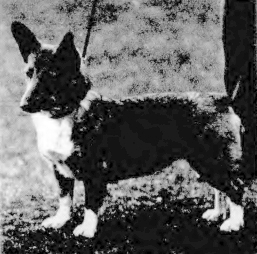
My Suze, winner at the L.K.A. Show, London. Owner: Capt. Checkland Williams |
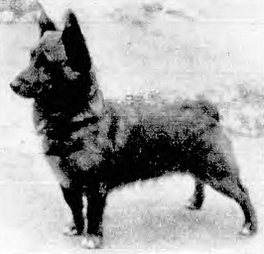
Ch. Cherry Bark, bred and owned by Mrs. Edith Morgan, a pioneer exhibitor |
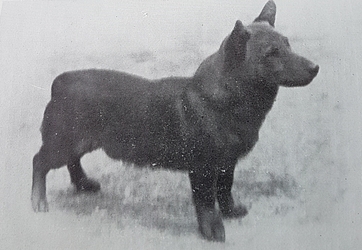
Ch. Bowhit Pivot, bred and owned by Mr. and Mrs. Sid Bowler |
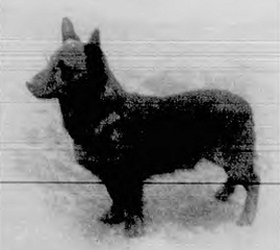
Ch. Bowhit Pepperson, his owner Sid Bowler of Haverfordwest, is one of England's best judges |
The reader will bear in mind that when the conquering Normans enacted their Forest Laws, they not only cut off the claws and parts of the toes of the fore-feet of farm dogs, but docked the dogs' tails at the roots. In later times, the owner of a tailless dog was untaxed. Today, farm corgis are exempt from taxation.
It is claimed by some writers that it is the corgi dog that Howel the Good, King of South Wales, refers to in his very curious Ancient Laws and Institutes of Wales, enacted by him in the beginning of the tenth century at his Hunting Lodge, in Carmarthenshire, and confirmed by the Pope. These contain much interesting legislation as to hunting and the dog.
It appears by these, says Jesse in his 'Researches', that the game laws among the Britons were much milder than those introduce by the Saxons, and still more by the Danes, and above all by the Normans into England.
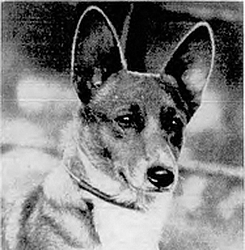
Torment of Sealy, which won an obedience trial
against shepherd dogs and poodles
Owner: Mrs. Victor Higgon, O.B.E.
Mrs. Victor Higgon, of Treffgarne Hall, near Haverford, Pembrokeshire, is not only among the chief breeders of the corgi of today, but for several years has been interested in the breed. Her daughter, Miss Frances Higgon, likewise is the judge and exhibitor of the Pembroke variety. At the championship show, held under the auspices of the Associated Sheep Police and Army Dog Society, at the Crystal Palace, London, October 24, 1935, Mrs. Higgon's corgi, Torment of Sealy, won in the novice class of nine working competitors. The other entries in this section were Alsatian, or German shepherd dogs, and poodles. As will have already been gathered, Torment was not only the single one of his breed, but the first of his kind to appear in any "performing" ring.
Following were the numerical values of perfect points as tabulated: Heel on leash, 10; Heel free, 30; Sit one minute, 10; Retrieving 2-pound dumb-bell on flat, 20; Recall to handler from the "down" or sitting position, 15; down-give minutes (handler out of sight), 35. Total 120 points. In the competition Torment of Sealy scored 118 points out of a possible 120. He was very good at his work, considering he had only been in training two months, and was little over a year old. As will be gathered from his photograph, Torment is possessed of a wise, understanding face. His color is red, with a little white. He had won consistently as a puppy at the various shows at which he was entered, and was first at Carmarthen in 1934.
It has been heard that the two points Torment lost in the Obedience Class, at the Crystal Palace, London, was when he dropped, for a moment only, the dumb-bell. But he made amends by picking it up at once without being told. He is being given more training, for the more advanced classes in the spring.
(To Be Continued) Part II
11.02.2021
